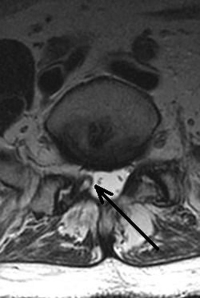Ganglion Cysts in the Lumbar Spine Overview
Ganglion cysts can occur in any joint. In fact, many people are aware of these but have never considered what they are. The small round “bumps” that occur under the skin at the wrist are typically ganglion cysts. Some individuals may remember the “Bible treatment” for these developed years ago where someone had the bright idea to smash a Bible onto the wrist to attempt to pop these cysts. This is not a recommended treatment for ganglion cysts in today’s world.
To understand what a ganglion cyst is, we must understand the design of a diarthrodial joint. This type of joint is the junction of two bones (such as the tibia and the femur at the knee). The surfaces of the joint are covered with a smooth slippery covering called hyaline cartilage. There is a thick burlap-like material that encases the entire joint called the capsule. This capsule is lined by a thin layer of cells called the synovium that produces the thin “oil” that lubricates the joint.
When the joint surfaces start to erode, as in degenerative arthritis, bone spurs start to form at the edges of the joint. Occasionally, the capsule encasing the joint will tear and the synovial lining will “pop out” of this tear. The synovial cells don’t know any better and therefore continue to produce synovial fluid. A cyst forms and will continue to grow. If the cyst grows in a region that has no sensitive structures, such as the wrist, there will be no symptoms. If however, the cyst grows in an area that will cause compression to structures that can’t take compression, symptoms will result.
It just so happens that the facets in the back of the spine are diarthrodial joints and exhibit degenerative changes quite commonly. The condition “degenerative spondylolysthesis” is one of the most common spinal disorders and is a result of wear and tear on the facet joints. (See the section on degenerative spondylolysthesis for further information on this condition). In a small number of patients with this condition, ganglion cysts in the lumbar spine will form.

(Click to Enlarge Image) This is an axial MRI of a small ganglion cyst that is compressing the right L5 nerve (black arrow) on the right. You can see that the facet joint it is originating from is degenerative (irregular surfaces) and the cyst is full of fluid (Black boarder of the cyst wall with white fluid inside).
Are you suffering from symptoms of a lumbar spine ganglion cyst?
Would you like to consult with Dr. Corenman about your condition?
You can set up a long distance consultation to discuss your
current X-rays and/or MRIs for a clinical case review.
(Please keep reading below for more information on this condition.)
Symptoms of Lumbar Spine Ganglion Cysts
If the ganglion cysts, as they commonly do, form outside the canal in the muscles in the rear of the spine, there will be no symptoms. If however, the cysts form in the canal itself, there will be trouble brewing. These cysts act like a bone spur or herniated disc and can compress the nerves in the canal. We know that nerves do not like to be pushed around and symptoms of nerve compression result. Depending upon the nerve, pain can radiate down into the buttocks and all the way down the leg (it is very rare to have these cysts cause problems in the neck-I have seen hundreds in the lower back and only two in the neck).
The symptoms of nerve compression are pain in the buttocks and leg normally worse with standing and better with sitting. There are cases of pain with sitting depending upon the position of the cyst.
Treatment of Lumbar Spine Ganglion Cysts
Non-Surgical
Treatment depends upon the symptoms that develop. Management such as epidural steroid injections and medications can be used. Physical therapy may not be as effective but may be useful. Occasionally, a good interventionist can drain the ganglion cyst and place steroid directly into the cyst which can shrink it.
Surgical
Surgery to remove the cyst is very effective. The cyst material is very sticky and sometimes it is difficult to remove all the cyst wall material if it sticks to the dura. (The dura is the lining of the sac that contains the nerves and the cerebral spinal fluid-CSF). Recurrence rate of the cyst is in the neighborhood of 10%. If the cyst is associated with a degenerative spondylolysthesis (as it is typically) and there is a significant slip or instability, occasionally a fusion of the segment is necessary.
For additional information on ganglion cysts in the lumbar spine, please contact Dr. Donald Corenman, back doctor and spine specialist offering diagnostic and surgical second opinions to patients in the USA and around the world.
Related Content
- When to Have Lower Back Surgery
- Causes of Lower Back Pain
- Normal Spinal Alignment
- Lumbar Anatomy
- How to Describe Your History and Symptoms of Lower Back and Leg Pain
- Best Questions to Ask When Interviewing a Spine Surgeon or Neurosurgeon
- Degenerative Spondylolisthesis
- Isolated Disc Resorption-Lumbar Spine (IDR)
- Lumbar Spinal Stenosis (Central Stenosis)
